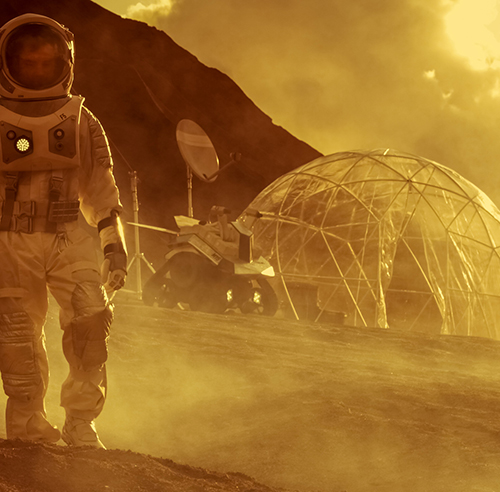This week's edition offers several good reasons to stay out of the cold: among them are a look at how women claimed their hard-won places in science, chances to museum hop on your laptop, a forecast of what human settlement in space might bring, and a warmly personal look at the joys of Yiddish-language theatre.
They're among the offerings designed to make sure you continue to enjoy what you,ve come to value from Smithsonian Associates: programs and experiences that are entertaining, informative, eclectic, and insightful.
A Lab of One's Own
 Rita Colwell (Photo: John T. Consoli/University of Maryland)
Rita Colwell (Photo: John T. Consoli/University of Maryland)
When Rita Colwell first applied for a graduate fellowship in bacteriology, she was told "We don't waste fellowships on women." In her nearly seven decades in science, Colwell, a pioneering microbiologist and the first woman to lead the National Science Foundation, has observed everything from sexual harassment in the lab to systems that block women from pursuing their chosen specialties, leading professional organizations, or publishing their work. Yet she and other women excelled despite the obstacles they faced. Drawing on her new book A Lab of One's Own: One Woman's Personal Journey Through Sexism in Science, Colwell examines how women successfully pushed back against the status quo—and what science gained in the process—in a Smithsonian Associates Streaming program on Thursday, January 21.
As Cowell and her fellow scientists can attest, for too long, women's contributions to the profession have widely gone untold. The Smithsonian Science Education Center, Smithsonian American's Women History Initiative, and Johnson & Johnson created the free digital book Stories of Women in STEM at the Smithsonian to champion the ingenuity that has transformed America and beyond. It features biographies of trailblazing women who made history through their scientific discoveries and innovation. From aerospace engineer and mathematician Mary Golda Ross to hair-care entrepreneur Madam C.J. Walker, learn how women have defied gender stereotypes and overcome structural barriers to advance in science, technology, engineering, and mathematics.
Register for the Program
View the Book
Art Picks to Click
 Illustration by Meilan Solly
Illustration by Meilan Solly
A year that offered only rare opportunities for museum-going managed to serve up a digital banquet for art lovers. Smithsonian magazine scouted the globe to produce a delicious list of the top ten online exhibitions of 2020. And though you can't stroll over to the museum store for that souvenir mug or tote bag afterward, a virtual visit can prove quite satisfying. The picks cover a wide range of themes and creators, including Jacob Lawrence at the Peabody Essex Museum; the sweeping Making the Met, 1870-2020; Dorothea Lange at MOMA; the Whitney's dynamic collection of works by 20th-century Mexican muralists; Jean-Michel Basquiat at Boston's Museum of Fine Art; and the National Portrait Gallery's Every Eye Is Upon Me: First Ladies of the United States. Innovative technology has shaped several of the exhibitions. A Belgian virtual reality company transformed a once-in-a-lifetime Van Eyck exhibition that was forced to close at the Museum of Fine Arts in Ghent into a 360-degree online experience. And in a new hyper-resolution view of Rembrandt's The Night Watch at the Rijksmuseum, viewers can pore over each detail of the Dutch master's most famous painting—down to every crack and stray paint splatter.
Read the Article
Yiddish Expression
 Photo by Mark Gulezian
Photo by Mark Gulezian
Growing up as the child and grandchild of Holocaust survivors, Fredie Adelman's home on New York's Upper West Side was one in which Yiddish was a living language. She was exposed to it on the radio and in the daily newspaper The Forward, but some of her deepest impressions came from performances at the Folksbiene, the National Yiddish Theater. Adelman, the director of Smithsonian Associates, honored that world of immigrant musical entertainment earlier in her museum career, a story she recounts in a recent recollection for Folklife, the digital magazine of the Smithsonian Center for Folklife & Cultural Heritage. She traces how Hooray for Yiddish Theater in America!, a 1985 exhibition organized for the B'nai B'rith Klutznick Museum in Washington, D.C., went on to crisscross the country for two years under the sponsorship of SITES, the Smithsonian Institution Traveling Exhibition Service. She also considers how Yiddish theatre's stories of ordinary people re-establishing themselves in unfamiliar places resonated with its New York audiences, inspired some of her later work in museum exhibitions, and kept vibrant an important element of the immigrant experience captured in the opening song of the recent record-breaking revival of Fiddler on the Roof mounted by the National Yiddish Theatre Folksbiene: "Traditisye, traditisye, traditsye!"
Read the Article
Space for Sale?

The 1960s generation watched as the first humans set foot on the moon. Our next could witness the construction of the first human settlements there, on Mars, and perhaps some of the asteroids. While much exploration has been driven by scientific curiosity and the human desire to explore new frontiers, commercialization is also raising questions about the effects of a growing human presence in space. In a Wednesday, March 17 program from Smithsonian Associates Streaming, Michael Summers, a professor of physics and astronomy at George Mason University, discusses how the use of space resources could propel human colonization throughout the solar system in the coming decades and beyond.
But can the demand for space resources be met? An international team of scientists led by the Center for Astrophysics | Harvard & Smithsonian, has identified a problem with the expanding interest in extractable resources on the moon: There aren't enough of them to go around. With no international policies or agreements to decide "who gets what from where," scientists believe tensions, overcrowding, and quick exhaustion of resources to be one possible future for moon mining projects. Some of their observations might bring sky-high expectations closer to earth.
Register for the Program
Read the Article